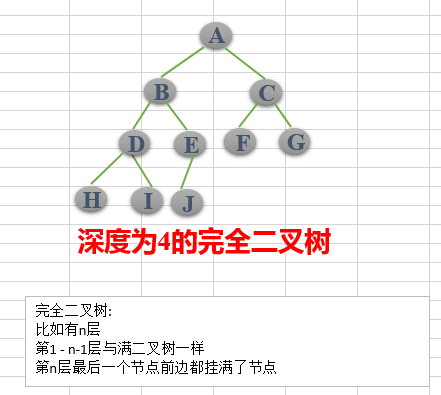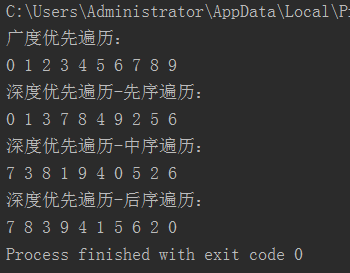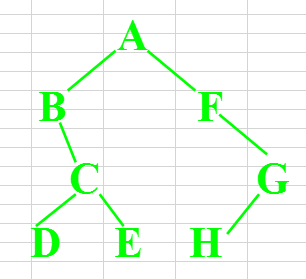(1)二叉树的基本概念:
二叉树是每个节点最多有两个子树的树结构。通常子树被称作“左子树”(left subtree)和“右子树”(right subtree)
(2)二叉树的性质(特性):
性质1: 在二叉树的第i层上至多有2^(i-1)个结点(i>0)
性质2: 深度为k的二叉树至多有2^k - 1个结点(k>0)
性质3: 对于任意一棵二叉树,如果其叶结点数为N0,而度数为2的结点总数为N2,则N0=N2+1;
性质4:具有n个结点的完全二叉树的深度必为 log2(n+1)
性质5:对完全二叉树,若从上至下、从左至右编号,则编号为i 的结点,其左孩子编号必为2i,其右孩子编号必为2i+1;其双亲的编号必为i/2(i=1 时为根,除外)
(1)完全二叉树——若设二叉树的高度为h,除第 h 层外,其它各层 (1~h-1) 的结点数都达到最大个数,第h层有叶子结点,并且叶子结点都是从左到右依次排布,这就是完全二叉树

(2)满二叉树——除了叶结点外每一个结点都有左右子叶且叶子结点都处在最底层的二叉树。

(3)二叉树的节点表示以及树的创建:
通过使用Node类中定义三个属性,分别为elem本身的值,还有lchild左孩子和rchild右孩子
class Node(object): """二叉树的节点类""" def __init__(self, item): self.elem = item self.lchild = None self.rchild = None
树的创建,创建一个树的类,并给一个root根节点,一开始为空,随后添加节点
class Tree(object): """二叉树类""" def __init__(self): self.root =None # 为二叉树添加节点 def add(self, item): node = Node(item) if self.root is None: # 特殊情况:如果为空树,直接加为根节点 self.root = node return queue = [self.root] # 对已有节点进行层次遍历 while queue: # 队列不为空则循环 注意特殊情况:bool([])=False bool([None])=True cur_node = queue.pop(0) # 弹出队列第一个元素 if cur_node.lchild is None: # 左子树为空直接加到左子树 cur_node.lchild = node return else: # 将其左子树添加到队列 queue.append(cur_node.lchild) if cur_node.rchild is None: # 右子树为空直接加到右子树 cur_node.rchild = node return else: # 将其右子树添加到队列 queue.append(cur_node.rchild)
(4)二叉树的遍历:
树的遍历是树的一种重要的运算。所谓遍历是指对树中所有结点的信息的访问,即依次对树中每个结点访问一次且仅访问一次,我们把这种对所有节点的访问称为遍历(traversal)。那么树的两种重要的遍历模式是深度优先遍历和广度优先遍历,深度优先一般用递归,广度优先一般用队列。一般情况下能用递归实现的算法大部分也能用堆栈来实现。
(5)广度优先遍历(层次遍历):
从树的root开始,从上到下从从左到右遍历整个树的节点
def breadth_travel(self): """广度优先遍历(层次遍历)""" if self.root is None: # 如果为空树,直接返回 return queue = [self.root] while queue: cur_node = queue.pop(0) print(cur_node.elem, end=" ") if cur_node.lchild is not None: queue.append(cur_node.lchild) if cur_node.rchild is not None: queue.append(cur_node.rchild)
(6)深度优先遍历:
对于一颗二叉树,深度优先搜索(Depth First Search)是沿着树的深度遍历树的节点,尽可能深的搜索树的分支。
那么深度遍历有重要的三种方法。这三种方式常被用于访问树的节点,它们之间的不同在于访问每个节点的次序不同。这三种遍历分别叫做先序遍历(preorder),中序遍历(inorder)和后序遍历(postorder)。我们来给出它们的详细定义,然后举例看看它们的应用。
先序遍历 在先序遍历中,我们先访问根节点,然后递归使用先序遍历访问左子树,再递归使用先序遍历访问右子树
根节点->左子树->右子树
def preorder(self, node): """先序遍历""" if node is None: return print(node.elem, end=" ") self.preorder(node.lchild) # 遍历左子树 self.preorder(node.rchild) # 遍历右子树
中序遍历 在中序遍历中,我们递归使用中序遍历访问左子树,然后访问根节点,最后再递归使用中序遍历访问右子树
左子树->根节点->右子树
def inorder(self, node): """中序遍历""" if node is None: return self.inorder(node.lchild) # 遍历左子树 print(node.elem, end=" ") self.inorder(node.rchild) # 遍历右子树
后序遍历 在后序遍历中,我们先递归使用后序遍历访问左子树和右子树,最后访问根节点
左子树->右子树->根节点
def postorder(self, node): """后序遍历""" if node is None: return self.postorder(node.lchild) # 遍历左子树 self.postorder(node.rchild) # 遍历右子树 print(node.elem, end=" ")
(7)测试代码:
if __name__ == "__main__": tree = Tree() tree.add(0) tree.add(1) tree.add(2) tree.add(3) tree.add(4) tree.add(5) tree.add(6) tree.add(7) tree.add(8) tree.add(9) print("广度优先遍历:") tree.breadth_travel() print("") print("深度优先遍历-先序遍历:") tree.preorder(tree.root) print("") print("深度优先遍历-中序遍历:") tree.inorder(tree.root) print("") print("深度优先遍历-后序遍历:") tree.postorder(tree.root)
(8)运行结果(将以上代码拼合到一起运行即可):

(9)深度遍历扩展练习:

练习: 按照如图树的结构写出三种遍历的顺序:

结果:
先序:a b c d e f g h
中序:b d c e a f h g
后序:d e c b h g f a
思考:哪两种遍历方式能够唯一的确定一颗树???